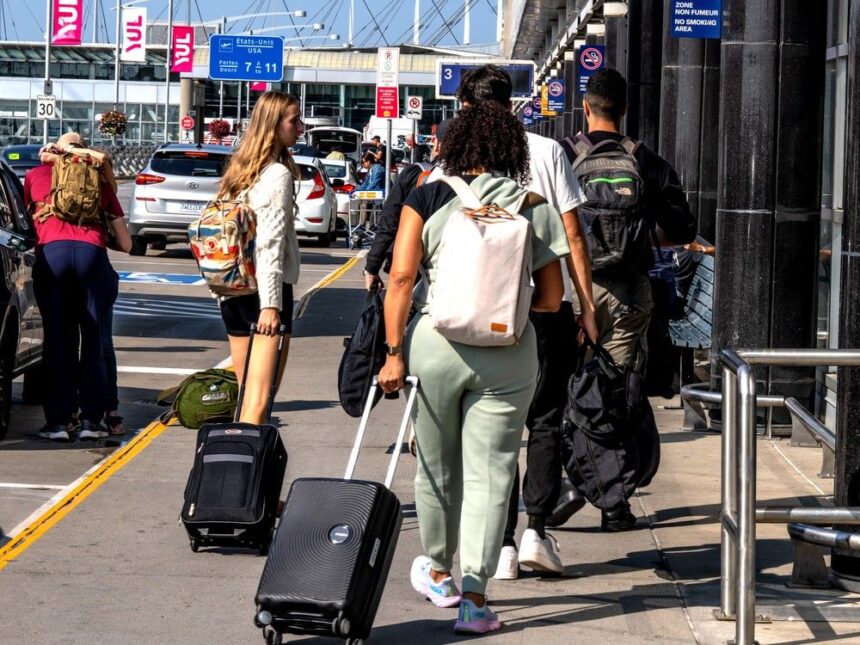U.S. border officials have quietly rolled out facial recognition technology at Pearson International Airport in Toronto and Montreal-Trudeau International Airport, dramatically cutting wait times for travelers heading stateside. The system, which compares live facial scans against passport photos, has slashed processing times from over two hours to just 30 minutes during peak periods.
For frequent flyers like Melissa Chen, a Toronto-based consultant who travels to Chicago twice monthly, the difference is remarkable. “I used to budget three hours before my flight. Now I’m through in under 20 minutes most days,” she told me during a recent visit to Pearson’s Terminal 1. “It’s actually made business travel bearable again.”
The U.S. Customs and Border Protection (CBP) introduced the technology earlier this spring without much fanfare, but its impact has been significant. According to CBP spokesperson Richard Weiss, the system has processed over 1.2 million travelers since March, with a 98.7% accuracy rate.
“This represents the future of secure, efficient border crossing,” Weiss explained in an email. “The average processing time has decreased by 63% while maintaining rigorous security standards.”
The system works by capturing a traveler’s image at a kiosk, then matching it against their passport photo and visa documentation already in CBP databases. Only U.S. citizens can opt out of the process, while Canadian and other international travelers must participate to gain entry clearance.
Privacy advocates have raised concerns about data retention and the expanding digital footprint at borders. The Canadian Civil Liberties Association noted in their April policy brief that biometric information collected at these crossings might be retained for up to 75 years in some circumstances, far longer than many travelers realize.
“The convenience factor is undeniable, but Canadians should understand what they’re trading for faster processing,” said Maya Goldstein, privacy director at the CCLA. “Once your biometric data enters U.S. systems, you have very limited control over how it’s used or shared.”
Air Canada and WestJet have embraced the technology, with both airlines now including information about the facial recognition process in pre-flight emails. The airlines report a 27% reduction in missed connections for U.S.-bound passengers since the system was implemented.
At Montreal-Trudeau, where I observed the system during a particularly busy Friday afternoon, travelers moved through the previously congested U.S. preclearance area with surprising efficiency. Most spent less than a minute at the facial recognition kiosk before proceeding to a CBP officer for final questions.
“C’est vraiment plus rapide maintenant,” remarked Jean-Philippe Tremblay, a Montreal business owner heading to Boston. “The system recognized me instantly even though my passport photo is seven years old.”
CBP officials emphasize that facial recognition doesn’t replace human officers but allows them to focus on travelers requiring additional screening. The number of CBP personnel at both airports remains unchanged despite the increased passenger throughput.
Transport Canada reports that U.S.-bound passenger volume has increased 18% in 2023 compared to pre-pandemic levels. Without technological solutions, wait times would have likely worsened significantly.
The technology has particularly benefited families traveling with young children. Previously, documenting and processing each family member could take substantial time. Now, the system quickly verifies all family members’ identities, though children under 14 still require parental consent for facial scanning.
Not everyone finds the process seamless, however. According to internal CBP data obtained through access to information requests, approximately 4% of travelers require manual verification after the system fails to match their facial scan with their passport photo. For these travelers, wait times can actually increase.
“I waited 40 minutes in a secondary screening line because the system couldn’t match my face to my passport,” said Omar Syed, a university professor I interviewed at Pearson. “The CBP officer told me beard length changes and different eyeglasses can sometimes confuse the algorithm.”
The technology’s rollout reflects broader trends in border management across North America. The NEXUS trusted traveler program has been using facial recognition since 2021, and Vancouver International Airport is slated to receive the technology next month.
Budget documents indicate the Canadian government has committed $24.5 million to biometric border technologies through 2025, suggesting similar systems may eventually appear at land border crossings and maritime ports of entry.
For most travelers, the immediate benefits outweigh privacy concerns. A recent Angus Reid poll found 72% of Canadian frequent flyers approve of biometric processing if it reduces wait times, though that number drops to 51% when respondents were informed about long-term data retention policies.
As I prepared to leave Pearson after my reporting, I watched an elderly couple approach the facial recognition kiosk with visible apprehension. The woman, likely in her late seventies, hesitated before positioning her face for the scan. Three seconds later, the screen flashed green. Her husband followed with similar success.
“Well, that wasn’t so bad after all,” she said, collecting her boarding pass. “Though I wonder where my face goes now.”
It’s a question more Canadians might want to ask as our borders become increasingly digital – balancing the undeniable convenience of faster processing against the less visible implications of biometric data collection that will long outlast our travel memories.






